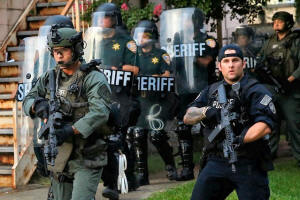|
In U.S. cities hit by killings, shared
concerns over cops' tactics, race
 Send a link to a friend
Send a link to a friend
 [July 18, 2016]
By Tom Polansek [July 18, 2016]
By Tom Polansek
(Reuters) - Nekima Levy-Pounds, president
of the Minneapolis chapter of the National Association for the
Advancement of Colored People, compares the city's mostly white police
department to "an occupying force" when its officers go into black
neighborhoods.
In Baton Rouge, minorities are "very wary of police and often afraid of
them," says Michele Fournet, a veteran criminal defense lawyer there.
Long before they were rocked this month by local police killings of
black men, the two U.S. cities were grappling with similar problems -
police forces viewed by many as overly aggressive and unrepresentative
of black communities.
Activists and residents in both places have urged law enforcement to
spend more time in neighborhoods building relationships and trust as
part of "community policing" efforts. Many would also like the cities to
hire more black officers.
Such calls having been growing across the country since the fatal police
shooting of Michael Brown, a black teenager, by a white officer in
Ferguson, Mo., in 2014. Since then, a wave of anti-police protests has
spread across the country fueled by high-profile police killings of
other black men, including Baltimore police detainee Freddie Gray last
year.

“Whether it’s Baton Rouge or Ferguson or Baltimore or Minnesota, we need
more community policing," said Cleve Dunn Jr., a black business man and
political consultant in Baton Rouge.
(Racial make-up of Baton Rouge, Minneapolis police:
http://tmsnrt.rs/29Bf9We)
Police spokesmen from Baton Rouge and Minneapolis, in statements, said
their departments had each made significant strides toward diversity in
their forces.
The Minneapolis Police Department said it has been "a national leader
and has set national 'best practice' standards in community engagement
and community policing."
Officials from St. Anthony, Minn., which provides police service to
Falcon Heights and employs the officer who shot Castile, did not respond
to questions.
Alton Sterling, the Baton Rouge man who was shot by police on July 5,
had peddled CDs for years and law enforcement officers would have known
he was not a threat if they were more familiar with the area, local
residents said.
One officer is notorious for harassing local black residents, to the
point where he has been given a street nickname of “Bro Stupid,” said
Burnell Williams, who works with at-risk youth and ex-prisoners for the
nonprofit group Against All Odds.
Blacks made up about 55 percent of Baton Rouge’s population in 2010, but
only 30 percent of the police force in 2013, according to U.S.
government data.
Similar disparities affect Minneapolis, near the tiny city of Falcon
Heights where Philando Castile was killed by a police officer during a
traffic stop on July 6.
STAFFING PROBLEMS
Blacks in Minneapolis were 8.7 times more likely than whites to be
arrested for low-level offenses, such as trespassing and disorderly
conduct, according to a study of arrests from 2012 to 2014 that the
American Civil Liberties Union of Minnesota published last year.
[to top of second column] |

Law officers march down a street during protests in Baton Rouge,
Louisiana, U.S. July 10, 2016. REUTERS/Shannon Stapleton/File Photo

Blacks accounted for about 19 percent of Minneapolis' population in
2010 but just about 9 percent of the city's police officers in 2013,
according to U.S. data.
Black residents of Minneapolis and nearby towns said the lack of a
requirement for police to live in the jurisdictions they patrol has
kept officers disconnected from neighborhoods. Some U.S. cities have
instituted residency requirements for police.
"You have mostly white officers patrolling a poor black neighborhood
where they have no real nexus to the community, where there are high
rates of complaints against the use of excessive force by police and
the over-criminalization of the African American community,"
Levy-Pounds said.
Some Minneapolis police and residents said staffing shortages
limited officers' ability to do more community policing.
Bob Kroll, president of the city's police union, said the department
needs to increase its numbers by about 20 percent. Without more
officers, "you're just going call to call to call, 9-1-1," he said.
Ronald Edwards, a black civil rights activist in Minneapolis who
contacted Reuters at the request of the police department, said he
believed the city's police chief was doing her best to improve race
relations.
However, he said "you don't have enough officers to deploy them and
do the things that really begin to break down the barriers between
people of different colors."
In Dallas, where five police officers were murdered in the wake of
the shootings in Minnesota and Louisiana, police Chief David Brown
told reporters on July 11 that community policing was the best way
to deter crime and protect officers.

Brown, a 33-year department veteran, noted that 2015 was the 12th
year of crime reduction in Dallas, more than any other major
American city.
Police "have done this by also protecting the civil rights of our
citizens," Brown said of the decline.
(Reporting by Lawrence Hurley, Ernest Scheyder, Letitia Stein, Nick
Carey and Tom Polansek; editing by Stuart Grudgings)
[© 2016 Thomson Reuters. All rights
reserved.]
Copyright 2016 Reuters. All rights reserved. This material may not be published,
broadcast, rewritten or redistributed. |